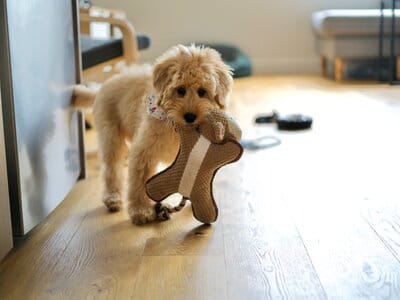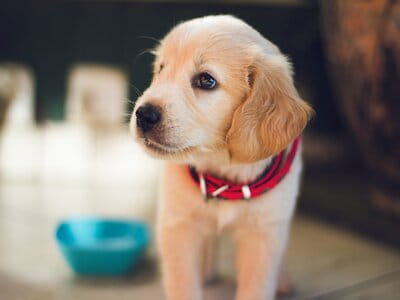
The number one goal of puppy proofing is your dog’s safety. There are many everyday objects that can pose a risk to dogs, especially when they’re young and curious. Cleaning supplies, sharp objects, medications, and choking hazards should all be filed away or kept out of reach (perhaps in self-storage). It’s worth checking out The Dogs Trust’s list of poisonous plants before moving them out of reach, too. Bins are another source of potential danger, as they are often full of choking hazards and substances that can be dangerous, such as xylitol, a common ingredient in chewing gum.
Puppy proofing the bedroom is mostly about protecting your possessions. Keep closets closed and move precious items out of the dog’s reach. Shoes are particularly attractive to a teething dog, so consider storing them in a closet or enclosed basket.
If you’re struggling to know exactly how to puppy proof your house, you can even lower yourself to the ground and look for items that a rambunctious pup might be tempted to chew on.
You won’t always be able to keep a watchful eye over your new puppy, so you need to create a safe place for it when you’re not around. A crate or small pen is the best option for a pup, but as it gets older, you may want to allow it to roam freely around an entire room or section of the house.
Always be sure to keep bathroom doors closed to keep them away from toiletries. Even drinking from the toilet, a habit of some dogs, can be hazardous depending on how recently the toilet has been cleaned and the types of cleaners used.
Baby-gates are an effective way to contain puppies and small dogs, although they’re not fool-proof. Determined dogs can sometimes wiggle through them or leap over them. For that reason, all area restrictions should be reinforced with training and discipline, using positive reinforcement to ensure that they aren’t tempted to stray from the safe parts of the house.

Harry Scott, Pet Product Marketing Manager at Nylabone told us, “puppies will naturally want to explore the world around them, have fun and discover new things and they will often do this by chewing, which can lead to trouble! But they can also be chewing for another good reason – teething – where all they want to do is help their new adult teeth through, rid the puppy ones and stop all the pain its causing. The teething period lasts roughly 6 months, starting at 3 months and lasting until they are around 9 months old.”
Harry continued, “Having a total of 42 teeth emerging through those little gums is bound to turn them to chew something he shouldn’t, unless you teach him to chew on appropriate items, which will also lead to a smooth transition from your teething pup to well-trained adult dog. Provide your puppy with a variety of chews and toys to entertain them, satisfying their need to gnaw on something while diverting them from chewing on inappropriate items. Only use products that have been specifically designed for puppies, if they are too hard, they could crack your puppy’s teeth, as well as ones that are too small or break apart and present choking hazards.”
It’s important to learn how to puppy proof cables before your pup moves in. Chewing-prone puppies could be at risk if they gnaw through a live electrical cable, so it’s important to ensure that cables are kept out of reach wherever possible.
Where cables must be exposed, consider spraying them with a doggy deterrent spray to make the wire smell and taste less appealing. It’s also important to run your hands along the cable to ensure that there are no frays or weaknesses in the insulating plastic that a dog could sink its teeth into. Puppies need to be supervised and discouraged from dangerous behaviours such as chewing cables, but with some positive reinforcement and plenty of chew toys, it is rarely an issue.
If you have the time, invest in pet-friendly home goods in advance of the puppy’s arrival. You may also need to do this if you have a dog with a long-term scratching habit. According to RSPCA pet insurance, “chipped wood off a door or furniture could get lodged in your pet’s throat and cause asphyxiation.” Metal is typically preferable to wood in terms of animal-resistance, and dense fabrics are less appealing to dogs when it comes to chewing.
Kelly Collins, the creative director at dog-friendly designer furniture company Swyft, says: "When thinking about choosing a sofa for your home that's puppy proof, always consider the rub count of the fabric and the ease of cleaning in case there's an accident. If you have a particularly scratchy dog or cat, I would go for velvet, which has a tighter weave so they can't get their claws in."
If you want to declutter in advance of your puppy’s arrival, consider using self storage. At Access Self Storage, we have stores across the country and a range of different storage lockers and storage units, sure to fit your needs. Check out our stores, including Access Self Storage Reading, Access Self Storage Portsmouth, Access Self Storage Islington.